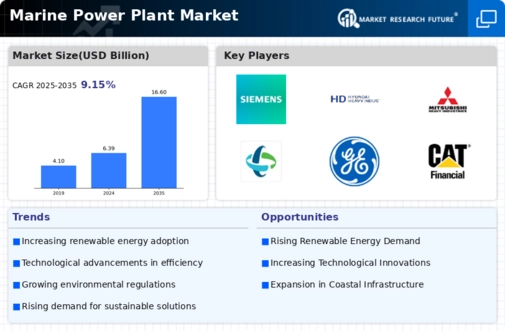Top Industry Leaders in the Marine Power Plant Market
*Disclaimer: List of key companies in no particular order
Top listed global companies in the Marine Power Plant industry are:
Caterpillar Inc. (US), Cummins (US), Hyundai Heavy Industries Co., Ltd. (South Korea), MAN Energy Solution (Germany), Mitsubishi Heavy Industries, Ltd. (Japan), Rolls-Royce plc (UK), Wärtsilä Oyj Abp (Finland), DAIHATSU DIESEL MFG. CO., LTD. (Japan), Doosan Infracore (South Korea), Fairbanks Morse (US), Hydraulic Marine Systems Inc. (US), Masson Marine (France), Samsung Heavy Industries (US), Siemens AG (Germany), and Mercury Marine (US).
Bridging the Gap by Exploring the Competitive Landscape of the Marine Power Plant Top Players
The marine power plant market, encompassing diverse solutions for powering vessels and offshore infrastructure, is a dynamic stage where established players and innovative entrants vie for dominance. Understanding the competitive landscape is crucial for navigating present conditions and anticipating future tides.
Key Players and Strategies:
Traditional powerhouses: Leading the pack are established engine manufacturers like Wärtsilä, MAN Energy Solutions, Caterpillar, and Rolls-Royce. Their strategies revolve around:
Fuel flexibility: Investing in technologies that handle diverse fuels like LNG, biofuels, and even ammonia, catering to decarbonization demands.
Efficiency optimization: Continuously improving engine efficiency to reduce fuel consumption and emissions.
Digitalization: Integrating data analytics and remote monitoring into their offerings for enhanced operability and maintenance.
Renewable contenders: Emerging players like OceanWind and SIMEC Atlantis are carving niches in renewable marine power plants, primarily focusing on:
Tidal and wave energy: Developing efficient and cost-effective tidal and wave energy harnessing systems for clean electricity generation.
Offshore wind integration: Providing floating wind turbine platforms for harnessing abundant offshore wind resources.
Modular solutions: Designing scalable and portable renewable power plants for smaller vessels and remote locations.
Market Share Analysis:
Determining market share in this evolving landscape requires considering several factors beyond traditional volume metrics:
Technology mix: The share of different power plant types - diesel, LNG, renewables - and their growth trajectories are crucial indicators.
Regional variations: Regional regulations, fuel availability, and infrastructure influence adoption patterns, demanding a nuanced understanding of each market.
Value chain positioning: Players involved in specific segments, like engine manufacturing, system integration, or operation and maintenance, need to be evaluated separately.
Emerging Trends and Strategies:
Several key trends are shaping the competitive landscape:
Decarbonization focus: Stringent emission regulations and climate goals are driving rapid adoption of cleaner technologies like fuel cells, hybrid power systems, and renewables. Players investing in these areas gain a competitive edge.
Digital transformation: Integration of digital technologies like AI, predictive maintenance, and IoT platforms is optimizing power plant performance and reducing operational costs. Players embracing digitalization stand to benefit.
Collaboration and partnerships: Strategic alliances and partnerships between established players and new entrants are fostering faster innovation and market penetration. Collaborative approaches to tackle technical challenges and address specific market needs are becoming increasingly common.
Overall Competitive Scenario:
The marine power plant market is characterized by intensifying competition driven by multiple factors:
Technological advancements: Rapid evolution of both conventional and renewable technologies is constantly reshaping the competitive landscape. Players need to adapt and innovate to stay ahead.
Evolving customer needs: Increasing focus on sustainability, fuel efficiency, and operational costs is demanding more diverse and flexible solutions from manufacturers.
Geopolitical uncertainties: Regional conflicts and fluctuating fuel prices can disrupt supply chains and impact market dynamics, requiring agile strategies from players.
In conclusion, the marine power plant market is a complex and dynamic arena where success hinges on adaptability, innovation, and strategic maneuvering. Understanding the diverse player strategies, key market share factors, and emerging trends is crucial for navigating the shifting currents and staying afloat in this competitive sea.
Latest Company Updates:
Wärtsilä Oyj Abp (Finland):
- December 2023: Unveils next-generation W46F dual-fuel engine, targeting 46% thermal efficiency and lower emissions. (Source: Wärtsilä)
Caterpillar Inc. (US):
- October 2023: Unveils new MaK 16V 46/63C four-stroke medium-speed engine, aiming for improved fuel efficiency and emissions reduction. (Source: Wärtsilä)
Cummins (US):
- September 2023: Introduces QSK60 marine generator sets, offering high power density and improved fuel efficiency. (Source: Cummins Inc.)
MAN Energy Solutions (Germany):
- December 2023: Collaborates with Mitsubishi Heavy Industries on joint development of ammonia-fueled two-stroke engine technology. (Source: MAN Energy Solutions)
Mitsubishi Heavy Industries, Ltd. (Japan):
- December 2023: Announces plans to build ammonia-powered fuel cell ship by 2026. (Source: Nikkei Asia)

